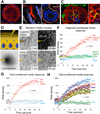Chemodetection and Destruction of Host Urea Allows Helicobacter pylori to Locate the Epithelium
- PMID: 26269952
- PMCID: PMC4593702
- DOI: 10.1016/j.chom.2015.07.002
Chemodetection and Destruction of Host Urea Allows Helicobacter pylori to Locate the Epithelium
Abstract
The gastric pathogen Helicobacter pylori interacts intimately with the gastric mucosa to avoid the microbicidal acid in the stomach lumen. The cues H. pylori senses to locate and colonize the gastric epithelium have not been well defined. We show that metabolites emanating from human gastric organoids rapidly attract H. pylori. This response is largely controlled by the bacterial chemoreceptor TlpB, and the main attractant emanating from epithelia is urea. Our previous structural analyses show that TlpB binds urea with high affinity. Here we demonstrate that this tight binding controls highly sensitive responses, allowing detection of urea concentrations as low as 50 nM. Attraction to urea requires that H. pylori urease simultaneously destroys the signal. We propose that H. pylori has evolved a sensitive urea chemodetection and destruction system that allows the bacterium to dynamically and locally modify the host environment to locate the epithelium.
Copyright © 2015 Elsevier Inc. All rights reserved.
Figures





Comment in
-
H. pylori GPS: Modulating Host Metabolites for Location Sensing.Cell Host Microbe. 2015 Aug 12;18(2):135-6. doi: 10.1016/j.chom.2015.07.013. Cell Host Microbe. 2015. PMID: 26269947
-
Helicobacter pylori: Lessons in bacterial attraction.Nat Rev Gastroenterol Hepatol. 2015 Oct;12(10):550. doi: 10.1038/nrgastro.2015.154. Epub 2015 Sep 1. Nat Rev Gastroenterol Hepatol. 2015. PMID: 26323880 No abstract available.
References
Publication types
MeSH terms
Substances
Grants and funding
- R01 DK101314/DK/NIDDK NIH HHS/United States
- U01 CA176299/CA/NCI NIH HHS/United States
- 2U01DK085527/DK/NIDDK NIH HHS/United States
- 1U01CA151920/CA/NCI NIH HHS/United States
- U24 DK085532/DK/NIDDK NIH HHS/United States
- 1U01CA168424/CA/NCI NIH HHS/United States
- U01 DK085532/DK/NIDDK NIH HHS/United States
- U19AI116484-01/AI/NIAID NIH HHS/United States
- U19 AI116484/AI/NIAID NIH HHS/United States
- R01DK101314/DK/NIDDK NIH HHS/United States
- U01 CA151920/CA/NCI NIH HHS/United States
- T32 AI007328/AI/NIAID NIH HHS/United States
- U01 DK085527/DK/NIDDK NIH HHS/United States
LinkOut - more resources
Full Text Sources
Other Literature Sources
Molecular Biology Databases

